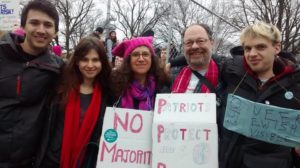What Role Can Nonstrategic Mass Movements Play in Social Change?
Are big protests a waste of time unless they’re part of an overall strategic plan? Nonviolent social change theorist George Lakey and I have been discussing this.
After my February post about Lakey’s idea that DT is creating enormous opportunities for social change workers, I got an interesting response from George (which I only just saw, thanks to a quirk in the WordPress interface). Please go read the original post and his response.
I believe my settings close comments after two weeks, and I couldn’t find a way to turn that off temporarily for this one post). So just to make sure there’s a way to keep the dialogue going, I’m posting my response here, as a new post, starting just below:

I agree with most of what you’d laid out here, George and certainly the key kernel that mass action makes the most sense as part of a well-thought-out and multidimensional campaign. And yet, I’m more optimistic than you about the power of a one-off mass action to build momentum for change. It has to be sustained, of course—but it can play a key role.
- My own involvement with the Movement began because I attended a mass rally about Vietnam, at age 12 (1969). One of the speakers said something that was life-changing for me. But it was not until I was in high school that I began to realize that the real work of social change happened in the meetings to plan those marches, more than the marches themselves—and to participate as other than a drone showing up to other people’s events.
- The reason all those no-nuke Alliances sprang up was because of what we did at Seabrook, a mass action.We inspired many other groups around the country to borrow our strategy, process, tactics, and even nomenclature, to organize affinity groups as we did, to educate about the issues around nuclear power and the safe-energy alternatives, and to be trained in nonviolent civil disobedience. And the reason we heard about Three Mile Island in the news two years later when we hadn’t heard about the earlier accidents at Enrico Fermi, Browns Ferry, and elsewhere was because of this national/international mass movement that started at Seabrook. It was having thousands at the site and 1414 arrested that pushed the issue into America’s consciousness. The first two Seabrook occupations almost a year earlier, much tinier, had almost no impact outside the local area.
- Occupy could have been much stronger with leadership and goals, I agree. But still the movement had a great deal of impact. Like Clam, some of its process innovations have become part of the Movement. You talk about those turned off by Occupy, but what I saw was a generation of young people who moved from inaction, maybe even apathy, to deep, personal, and highly inconvenient action. They made sacrifices for social change. And I think a lot of them moved into actual organizing after the camps closed.
- The recent Women’s March had very little strategy behind it but sparked the immediate and clear message that resistance is mainstream, that DT does not represent normal, and that oh yes, there was something we could do. And of course, it provided yet another opportunity for DT to make a fool of himself saying ridiculous things about the protests. I don’t remember another time when nonviolent protests unscrewed the legs of legitimacy from a government less than one day old. And again, a lot of folks who had never done anything political went from the march to the meetings. The thousands of hives of the resistance were enormously strengthened by that unstrategic mass event.
I’m glad you brought up the business community. This is where I have very strategically placed most of my own organizing in recent years: showing that business can create meaningful social change, not out of guilt and shame but out of enlightened self-interest: the profit motive. This is the subject of my 10th book, Guerrilla Marketing to Heal the World, as well as my “Impossible is a Dare” talks. It’s the opposite of mass organizing: small groups and even one-to-one conversations.
So yes, let’s incorporate big protests into a wider strategic view, as the Civil Rights organizers did. Let’s read Alinsky and Gene Sharp, MLK and Gandhi, Barbara Deming and Dorothy Day, and of course, George Lakey. Let’s study the successes AND weaknesses of all these movements including Occupy, BLM, and the current resistance. And lets create strategies that keep the needle moving, both publicly and behind the scenes, toward the world we want. Outside of my social change work through my business, I’ve been focusing my own parts of the resistance on the amazing opportunity to get people who haven’t been talking to each other not just talking but supporting and acting in solidarity. I see this work—and especially the chances for Jews and Muslims to work together in solidarity—as deeply strategic based on seizing the moment where a conversation is much easier to have under the lens of both groups being under threat.
PS: George, I apologize for the late reply. WordPress only showed me your waiting comment last night. I approved it immediately but wanted to bring my much clearer early-morning thinking to my response. [end of my quoted response]
